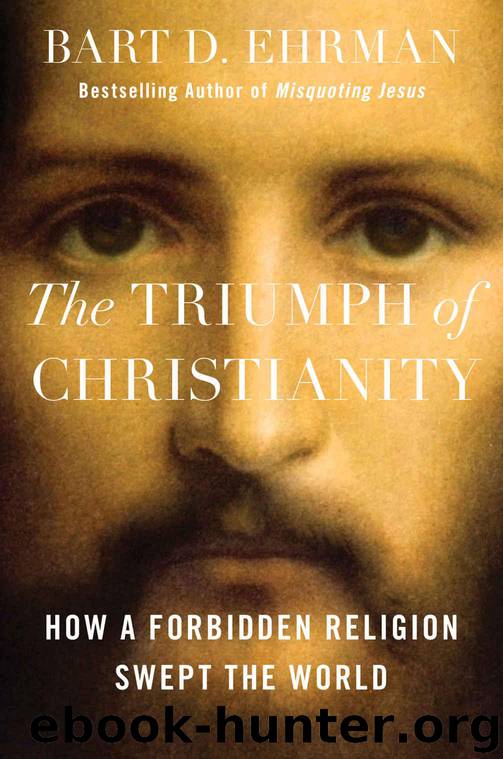The Triumph of Christianity: How a Forbidden Religion Swept the World by Ehrman Bart D

Author:Ehrman, Bart D. [Ehrman, Bart D.]
Language: eng
Format: azw3
Publisher: Simon & Schuster
Published: 2018-02-13T05:00:00+00:00
THE DEMOGRAPHICS OF CONVERSION
First, it is important to consider several matters of demographics. The vast bulk of the ancient population comprised lower classes. The very upper crust of the aristocracy—the senators of Rome, the next level down known as the equestrians, and the local elite of cities throughout the empire called decurions—altogether made up just over 1 percent of the total population. With respect to the other 99 percent, there was not much of a middle class to speak of in Rome’s noncapitalist, preindustrial society. There were, to be sure, large differences in wealth, even in a world where the great majority of people were living on the economic edge. But the majority of people did live on that edge, including most of the people coming into the Christian faith. Pagan intellectuals such as Celsus may have mocked Christians for being attractive principally to the poor and uneducated, but the reality is that this was most of the population.
For reasons I have already explained, it proved much easier to convert people in urban settings than in rural ones. The urban centers were packed with people. Rome itself had a population of nearly two hundred persons per acre, and the number on the ground was much higher than that, since about a quarter of the city was public space without housing. Such dense populations made human interchange much more frequent than in rural settings. As MacMullen points out, “the narrower one’s house, the more time would naturally be spent among one’s neighbors, the more intercourse and friendliness, the more gossip and exchange of news and sense of fraternity.”9 And, accordingly, the more opportunities for conversion, as information about this new cult could spread like wildfire, no less quickly than rumor and gossip.
It is clear that Christianity grew at different rates in different cities and regions. Both literary and archaeological sources confirm there were far more converts in the East than the West in the first three hundred years; it was not until the end of the second century that western provinces began to be seriously Christianized at all. Rome itself was an obvious exception. Moreover, some parts of the East—for example, Asia Minor—saw Christian growth much more quickly than others.
Egypt is a good example. One of the fascinating studies of the Christianization of Egypt was undertaken by a Roger Bagnall, at the time a professor of ancient history at Columbia.10 Bagnall applied an interesting method for determining how quickly Egypt became Christianized. It had to do with a field called “onomastics,” the study of personal names. As Christianity spread throughout the empire, Christians started giving their children Christian names. As an obvious example, Peter was not a name at all in antiquity before Christians arrived on the scene. The name Peter is based on a nickname given to one of Jesus’s disciples, Simon son of Jonah (John 1:42). It is a word that means rock. We are not sure why Jesus wanted to call Simon “the Rock,” but he did, and years afterward Christians would sometimes give their children the name of this famous disciple.
Download
This site does not store any files on its server. We only index and link to content provided by other sites. Please contact the content providers to delete copyright contents if any and email us, we'll remove relevant links or contents immediately.
The Gnostic Gospels by Pagels Elaine(2459)
Jesus by Paul Johnson(2294)
Devil, The by Almond Philip C(2266)
The Nativity by Geza Vermes(2165)
The Psychedelic Gospels: The Secret History of Hallucinogens in Christianity by Jerry B. Brown(2112)
Forensics by Val McDermid(2030)
Going Clear: Scientology, Hollywood, and the Prison of Belief by Lawrence Wright(1925)
Going Clear by Lawrence Wright(1910)
Barking to the Choir by Gregory Boyle(1774)
Old Testament History by John H. Sailhamer(1758)
Augustine: Conversions to Confessions by Robin Lane Fox(1727)
The Early Centuries - Byzantium 01 by John Julius Norwich(1690)
A Prophet with Honor by William C. Martin(1672)
A History of the Franks by Gregory of Tours(1671)
Dark Mysteries of the Vatican by H. Paul Jeffers(1660)
The Bible Doesn't Say That by Dr. Joel M. Hoffman(1640)
by Christianity & Islam(1585)
The First Crusade by Thomas Asbridge(1567)
The Amish by Steven M. Nolt(1523)
